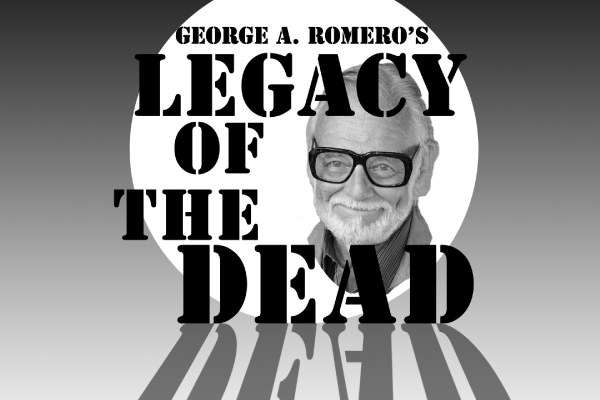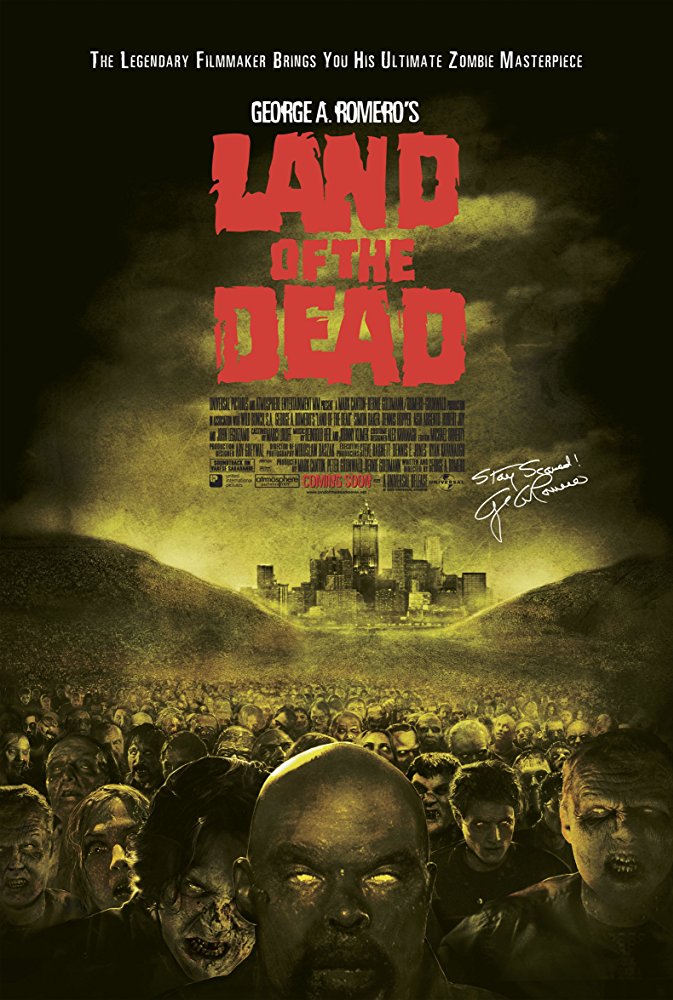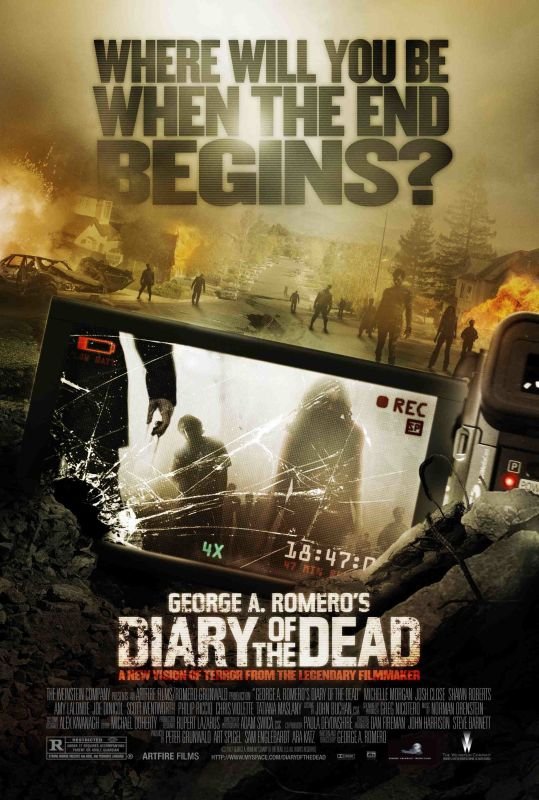
George Romero left his zombie films behind with the end of the Cold War, only to return to the genre with "Land of the Dead" in 2005. As America began to polarize into red states and blue states during the early years of the War on Terror, Land picks up several years after the initial zombie outbreak with an equally divided society. In it Romero's attention to the arming of America satirizes private security forces and the use of the military or National Guard to protect wealthy enclaves. "Diary of the Dead" (2007) timeslips back to the beginning days of the outbreak, with radio and television replaced by emerging Internet media including video blogs that lampoon the mainstream press and expose the failures of government agencies and National Guard units to protect the public. "Survival of the Dead" (2009) immediately follows the events of "Diary," tracking the breakdown and collapse of the authority by featuring a National Guard unit who desert their posts, becoming bandits and hired guns.
 There is no standing army in "Land of the Dead," just the survivors of National Guard units who attempt to defend the downtown of post-apocalyptic Pittsburgh and the paramilitary mercenaries who stage raids on outlying towns infested with undead. The censure of the Guard is not directed at individual troops, but instead at those who set policy and strategy, such as Donald Rumsfeld. Dennis Hopper explained that he modeled his portrayal of Paul Kaufman, the ruler of this semi-feudal enclave, on Rumsfeld.
There is no standing army in "Land of the Dead," just the survivors of National Guard units who attempt to defend the downtown of post-apocalyptic Pittsburgh and the paramilitary mercenaries who stage raids on outlying towns infested with undead. The censure of the Guard is not directed at individual troops, but instead at those who set policy and strategy, such as Donald Rumsfeld. Dennis Hopper explained that he modeled his portrayal of Paul Kaufman, the ruler of this semi-feudal enclave, on Rumsfeld.
By the late 1990s, after the collapse of the Soviet Union, the U.S. military began to reduce forces and transition to a leaner, post-Cold War force. The remaining standing army would be augmented by National Guard units when required. The Rumsfeld Doctrine called for the transformation of U.S. armed forces into smaller, more nimble units of conventional forces supported by high-technology and air strikes. In "Land" this translates into Dead Reckoning, the armored personnel carrier with machine guns and rocket launchers used by Kaufman's mercenaries to raid the countryside. However, while policy called for more and better technology, the rapid and repeated deployments of Guard units often put them in the field without the armor and support they required, leading to repeated public criticism but little additional support. Many of those who joined the National Guard pre-9/11 did so for college tuition benefits and cash bonuses, never expecting to be deployed to a battlefield.
In "Land," this lack of experience is translated into complacency; the surviving veterans are stationed on the edge of the enclave, trusting in the protection of its rivers. When the zombie, Big Daddy, leads the horde across the river underwater, they surprise and massacre the ill-prepared Guard. Rather than being integrated into his planned community, Kaufman kept them assigned to the periphery so his security forces would have free reign over the black market, prostitution, and the gambling that kept the masses distracted.
Romero also turned his attention to the growing use of private security forces in America by portraying private armed security as enforcers and assassins in "Land." Somewhat eerily, before the clash of New Orleans refugees with private security in the aftermath of Hurricane Katrina or the controversies rising from private armed contractors like Blackwater in Iraq, Romero depicted armed private security forces as tools of the elites. The film's primary critique is of the wealthiest, but those with money and power not only hire the disenfranchised to guard the rest, but also to inform on their revolutionary activism. Kaufman pays Cholo, a Latino mercenary, to take extra risks for luxury goods, beyond the primary mission of the raiders to secure supplies for survival. Kaufman never even considers that Cholo is taking these risks only as a means to buy his way into the secure, luxury residences of Fiddler's Green. Kaufman not only denies Cholo a place (class and ethnicity play their parts), but also orders his private security to assassinate Cholo; the guard fails. Romero's satire is visual and direct: the uniforms of the security forces are drawn from the history of World War II. Tools of the fascists, they are dressed in pressed, gray uniforms, sporting peaked caps, with patent black leather boots and Sam Browne belts, reminiscent of the uniforms of Mussolini's guard and Hitler's S.S. Gestapo.
Not only are the Guard in the tower inept, those who are sent outside the wire also fail in their mission, emphasizing their incompetence. Three security guards are sent with Riley, but two are bitten by zombies and shot, while the third defects to Riley's team. While under the thumb of Kaufman's security, neither the rich nor the poor are allowed weapons in the city; when the dead invade, the rich are trapped by an electric fence, they are slaughtered, but many of the poor hide and survive. Romero offers a more nuanced message: with the 'termination' of the security contract, the poor are able to pick up the discarded weapons, and retake the city from the undead.
 "Diary of the Dead" focuses on a small group of film students and their professor as they navigate the roads of the rising, attempting to find family and then refuge from the undead. The conflicting reports they view on the Internet leave them confused, bewildered, and even after they encounter their first undead, a state trooper whose uniform and flesh are still smoking from a vehicle fire, disbelieving. The Department of Homeland Security has moved its color alert to orange, while the President monitors events from his ranch, but it is unclear whether any action is being taken to protect citizens. The footage they view shows police and EMTs attacked by the undead, and later, a group in a mixture of HAZMAT suits and body armor, hunting the undead in an apartment building, perhaps a reprise of the tenement scenes of 1978's "Dawn of the Dead." As with the SWAT team, these armed units accidentally release the undead, and when bitten, turn their wrath on any civilians present, most of whom are implied to be family. The primary mission is to destroy the enemy, civilians are collateral damage, covered up by official responses, but not uploaded guerilla video, reflecting reports of civilian casualties in Iraq and Afghanistan.
"Diary of the Dead" focuses on a small group of film students and their professor as they navigate the roads of the rising, attempting to find family and then refuge from the undead. The conflicting reports they view on the Internet leave them confused, bewildered, and even after they encounter their first undead, a state trooper whose uniform and flesh are still smoking from a vehicle fire, disbelieving. The Department of Homeland Security has moved its color alert to orange, while the President monitors events from his ranch, but it is unclear whether any action is being taken to protect citizens. The footage they view shows police and EMTs attacked by the undead, and later, a group in a mixture of HAZMAT suits and body armor, hunting the undead in an apartment building, perhaps a reprise of the tenement scenes of 1978's "Dawn of the Dead." As with the SWAT team, these armed units accidentally release the undead, and when bitten, turn their wrath on any civilians present, most of whom are implied to be family. The primary mission is to destroy the enemy, civilians are collateral damage, covered up by official responses, but not uploaded guerilla video, reflecting reports of civilian casualties in Iraq and Afghanistan.
When "Diary" was released in the summer of 2007, public sentiment had started to turn against the war as more troops began to return home with traumatic injuries and signs of Post Traumatic Stress Syndrome. When the students are ambushed by three African-American men with weapons, their RV is escorted into a supply depot in Philadelphia. None are in uniform, the majority are Black, and when asked about government response, their leader, played by Martin Roach, says he is in the National Guard. Rather than remaining with his unit, he has chosen to protect his local community because they are being lied to by the media or the government. He explains that they are not looting, but concentrating and protecting resources, that now they 'have the power, for the first time, because everyone else left.' He supplies the students with food, water, fuel, and weapons before they continue their trek to Scranton. Unfortunately, they are stopped by a National Guard unit who rob them of everything other than their weapons, because they are only thieves, not murderers.
 The National Guard unit from "Diary" takes central stage in "Survival of the Dead," with the timeline again skipping back a few days to explain why they go AWOL and become bandits. Romero's introduction sums it up as 'this movie is about some National Guardsmen who have given up on the National Guard.' Officers are singled out for a particularly harsh critique--when the commanding officer, a lieutenant, will not shoot one of his men who has turned, he is himself bitten. The enlisted officer, Sergeant Crockett, then shoots both of them before taking his unit and leaving the outpost. This effectively ends the organized military defense of this supply depot and any refugees. Repeating the message of 1985's "Day of the Dead," the Guardsmen leave because command has failed them in policy and in the field. The unit has guns and ammunition, but chooses to prey on other survivors (the college students of "Diary") to supply their escape. After the students, Crockett leads his unit to act as bandits by ambushing a group of well-armed survivors who have stolen an armored car; automatic weapons again outmatch rifles and shotguns.
The National Guard unit from "Diary" takes central stage in "Survival of the Dead," with the timeline again skipping back a few days to explain why they go AWOL and become bandits. Romero's introduction sums it up as 'this movie is about some National Guardsmen who have given up on the National Guard.' Officers are singled out for a particularly harsh critique--when the commanding officer, a lieutenant, will not shoot one of his men who has turned, he is himself bitten. The enlisted officer, Sergeant Crockett, then shoots both of them before taking his unit and leaving the outpost. This effectively ends the organized military defense of this supply depot and any refugees. Repeating the message of 1985's "Day of the Dead," the Guardsmen leave because command has failed them in policy and in the field. The unit has guns and ammunition, but chooses to prey on other survivors (the college students of "Diary") to supply their escape. After the students, Crockett leads his unit to act as bandits by ambushing a group of well-armed survivors who have stolen an armored car; automatic weapons again outmatch rifles and shotguns.
Unlike the SWAT members of Dawn who choose to join with civilians to form a community, Crockett and his people seek refuge but not society on Plum Island, somewhere off the coast of Delaware. They are led by an outcast, the former O'Flynn patriarch, and come as invaders and strangers. Although they wear uniforms they are not received as authorities but rightly viewed as threats, losing two members before entering into the clan warfare between the Muldoons and O'Flynns. Instead of providing a source of security or civil order, the Guard destabilize the situation and escalate confrontation into conflict, with the feuding humans destroying themselves. By the end of the film, only Crockett, the female Guardsman, Tomboy, and the Boy they adopt into the group remain alive, once again in search of a sanctuary and dangerously low on supplies. As Guard, citizen-soldiers, Crockett and his survivors might suggest that only armed citizens can survive in a world given over to fear, but if so it is at the cost of family and community. In each of Romero's zombie films, the police and armed forces fail to preserve order, protect citizens, or defeat those attacking the nation. It isn't control of the best weapons that ensures survival, but cooperation, trust, and collaborative work to maintain and secure the community. Rifles and machine guns tend to help.
Internet Movie Database (N.D.). 'Land of the Dead Poster' (2005)
Internet Movie Database (N.D.). 'Diary of the Dead Poster' (2007)
Internet Movie Database (N.D.). 'Survival of the Dead Poster' (1985)
by Rikk Mulligan, Digital Scholarship Strategist
